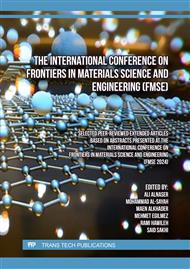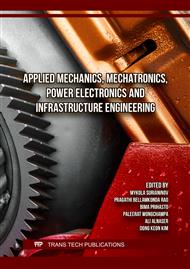[1]
V.H. Khatawate, J. Sheth, and P. Tulasyan, "Structural Analysis of the Upright of a FSAE Race Car," in Proceedings of International Conference on Intelligent Manufacturing and Automation, Singapore, H. Vasudevan, V.K.N. Kottur, and A.A. Raina, Eds., 2020//2020: Springer Singapore, pp.543-554.
DOI: 10.1007/978-981-15-4485-9_56
Google Scholar
[2]
D. Seward, "Upright design and analysis ," in Race car design, London: Palgrave, 2014, p.169–175.
Google Scholar
[3]
T.Y. Pang and M. Fard, "Reverse Engineering and Topology Optimization for Weight-Reduction of a Bell-Crank," Applied Sciences, vol. 10, no. 23.
DOI: 10.3390/app10238568
Google Scholar
[4]
T.V. Truong, M. Debiasi, U. Kureemun, and H. P. Lee, "Structural optimization of a flapping wing micro air vehicle," in 2016 7th International Conference on Mechanical and Aerospace Engineering (ICMAE), 18-20 July 2016, pp.476-479.
DOI: 10.1109/ICMAE.2016.7549587
Google Scholar
[5]
C. Ramonell and R. Chacón, "On the topological optimization of horizontal links in eccentrically braced frames," Journal of Constructional Steel Research, vol. 185, p.106887, 2021/10/01/ 2021.
DOI: 10.1016/j.jcsr.2021.106887
Google Scholar
[6]
P. Yao, K. Zhou, Y. Lin, and Y. Tang, "Lightweight Topological Optimization for Upper Arm of an Industrial Welding Robot," Metals, vol. 9, no. 9.
DOI: 10.3390/met9091020
Google Scholar
[7]
M. Islam, N. Nithish., and M. Nithish, "Design and Optimization of FS Vehicle Upright," International Journal of Engineering Science and Computing, vol. 10, (2020)
Google Scholar
[8]
P. Prajwal, "Design and optimization of formula one student sports car upright using hypermesh," in International Journal of Mechanical and Industrial Engineering, vol. 2, no. 4.
DOI: 10.47893/IJMIE.2013.1088
Google Scholar
[9]
O. Babannavar and A. M. Deshpande, "Design, analysis, and optimization of an FSAE upright," IOP Conference Series: Materials Science and Engineering, vol. 1166, no. 1, p.012043, 2021/07/01 2021.
DOI: 10.1088/1757-899X/1166/1/012043
Google Scholar
[10]
L. Siva Rama Krishna, N. Mahesh and N.Sateesh, "Topology optimization using solid isotropic material with penalization technique for additive manufacturing," Materials Today: Proceedings, vol. 4, (2), pp.1414-1422, 2017.
DOI: 10.1016/j.matpr.2017.01.163
Google Scholar
[11]
G. Allaire, F. Jouve and A. Toader, "Structural optimization using sensitivity analysis and a level-set method," Journal of Computational Physics, vol. 194, (1), pp.363-393, 2004. Available: https://dx.doi.org/10.1016/j.jcp.2003.09.032.
DOI: 10.1016/j.jcp.2003.09.032
Google Scholar
[12]
G. ALLAIRE et al, "Shape optimization by the homogenization method," Numerische Mathematik, vol. 76, (1), pp.27-68, 1997.
DOI: 10.1007/s002110050253
Google Scholar
[13]
J. HIRSCH, "Recent development in aluminium for Automotive Applications," Transactions of Nonferrous Metals Society of China, vol. 24, no. 7, p.1995–2002, 2014.
DOI: 10.1016/s1003-6326(14)63305-7
Google Scholar
[14]
G. S. Cole and A. M. Sherman, "Light weight materials for automotive applications," Materials Characterization, vol. 35, no. 1, p.3–9, 1995.
DOI: 10.1016/1044-5803(95)00063-1
Google Scholar
[15]
P. Allen, J. R. Davis, and S. R. Lampman, Metals handbook. vol. 2: Properties and selection: Nonferrousalloys and special-purpose materials, 10th ed., vol. 2. Metals Park, OH (USA): ASM International, 1990.
Google Scholar



